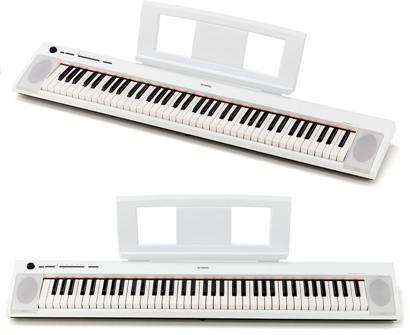
Review and Opinion of the Yamaha NP-32 Piaggero Where to Buy It?
Yamaha has been for some time now one of the biggest producers of musical instruments, including digital pianos. Now we will have the review of the Yamaha NP-32 Piaggero which is priced at €298/£272. A well-priced keyboard that has a good mix of features:
- 76 touch-sensitive keys
- 64 notes of polyphony (Number of notes that can be played at once. This includes accompaniments that also consume notes. So if you play on top of an accompaniment more notes will be accumulated)
- 10 sounds (Different sounds of piano and other instruments)
- 10 demo songs
- Dual function (Dual mode allows you to combine two sounds to create a more complete one. Typical is the combination of piano + stringed instrument sound) or layer
- Reverb effect (Reverb effect)
- Metronome (Basic study element to study and practice the tempo of a piece of music)
- Transposition (Transposition allows you to move the note spectrum of a keyboard. This is to be able to play with transposing instruments. It is not an easy concept but it is made to facilitate the writing of an orchestration for instruments with very different bass and treble registers)
- Recording capacity
- 2 x 6W medium power speakers
- Input for sustain pedal (The sustain pedal of a piano or keyboard is used to keep the note playing even if you stop pressing the key) not included
- Hull exit
- USB midi (MIDI allows you to do such wonderful things as connect your keyboard to your computer, record a sound track and with certain programs click through what you’ve played to musical notes on a score. MIDI tracks store the information of the musical notes)
- Includes lectern
- Also supports batteries
- Includes PA-150 power supply
- A weight of 5.7kg and measures 1244 x 259 x 105mm
I’ll leave a one video to hear how it sounds. The first is an unofficial review and the second is the official Yamaha video:
Related post you can be interested in
- Ranking with the best digital pianos
- My selection of cheap musical keyboards.
- Basic concepts you need to know about digital pianos.
- The best resources to learn to play the piano by yourself.
- The best Yamaha Digital Pianos.
Now let’s compare the Yamaha NP 32 Piaggero with its more common alternatives. Also at the end of the post you will find a section with the best shopping possibilities for this digital piano. But you can go directly to that part of the post by pressing the following button.
Yamaha NP-32 Piaggero vs Casio CDP-130
Let’s compare the Yamaha NP-32 Piaggero keyboard with a price of €298/£272 and the Casio CDP-130 with a price of €313. Now we’ll have a face-to-face look at their respective features to see their most notable differences:
- First of all we find that the Yamaha has 76 keys with touch sensitivity, while the Casio has 88 weighted keys with touch sensitivity and hammer simulation. Weighted keyboard, is the weight that the keys have to simulate those of an acoustic piano, in the bass more weight and while going to the higher more lightweight. Sensitivity refers to that s can give dynamics by pressing the stronger keys, sounds higher and pressing with less force. lower.
- The Yamaha has 10 sounds, 64 notes of polyphony and 10 demo songs, while the Casio has 10 sounds, 48 notes of polyphony and 5 demo songs. Polyphony is the maximum number of notes that can be played simultaneously on a piano.
- Both have effects like: Reverb, Chorus.
- The Yamaha has 2 x 6W speakers and the Casio has 2 x 8W speakers, with the second one being slightly more powerful.
- Both have metronome and transposition capabilities, as well as a USB MIDI connection that allows them to be connected to a computer to be used as MIDI controllers in a music composition or production program. The Yamaha can be connected to iOS devices such as iPhone/iPad for use with Apps such as Flowkey, to enhance learning.
- Both have a sustain pedal input, on the NP32 this is not included, while on the CDP130 it is.
- The Yamaha NP32 has a very light weight of 5.7kg and measures 1244 x 259 x 105mm, while the Casio DP130 weighs 11.4kg and measures 322 x 286 x 129mm (W x D x H).
The NP 32 is a very lightweight, high-performance keyboard. This makes it perfect for moving around as it supports batteries. A very interesting option if you do not find the Casio CDP 130 is the Casio CDP S100.
We will put the characteristics of each of these pianos in 2 different columns to make it easier to see the differences:
|
Yamaha NP-32 Piaggero |
Casio CDP-130 |
|---|---|
|
|
And now a video of the Casio CDP-130
If you want to know more about this model don’t miss our review of the Casio CDP-130.
Yamaha NP-32 Piaggero vs Thomann DP-26
Now let’s compare two Yamaha NP32 Piaggero digital pianos that are priced at €298/£272 and the Thomann DP-26 that is priced at €311/£279. One difference we can notice at first glance is that the DP33 is a digital piano with a cabinet included, while the DP26 is a digital piano without a cabinet. Let’s check which is the best keyboard for you according to the features each one offers:
- The Yamaha has 76 keys with touch sensitivity, while the Thomann DP26 has 88 weighted keys with touch sensitivity and hammer action. Weighted keyboard is the weight of the keys to simulate those of an acoustic piano, with the bass keys being heavier and the treble keys lighter. Sensitivity refers to that s can give dynamics by pressing the stronger keys, sounds higher and pressing with less force. lower.
- The Yamaha has 10 sounds, 64 notes of polyphony and 10 demo songs, when the DP26 has 20 sounds, 64 notes of polyphony and 2 demo songs. Polyphony is the maximum number of notes that can be played simultaneously on a piano.
- Both have modes: dual, layer and split, and effects like: Reverb, Chorus. The Thomann also includes a Master EQ.
- The Yamaha has two 6W speakers and the Thomann has two 10W speakers, being more powerful than the second one.
- Both have metronome and transposition capabilities, as well as a USB MIDI connection that allows them to be connected to a computer to be used as MIDI controllers in a music composition or production program. The Yamaha can be connected to iOS devices such as iPhone/iPad for use with Apps such as Flowkey, to enhance learning.
- Both have sustain pedal input, on the Yamaha it is not included, while on the Thomann it is.
- The Yamaha NP32 has a very light weight of 5.7 kg and measures 1244 x 259 x 105mm, while the Thomann DP-26 has a weight of 13 kg and dimensions of 1365 x 366 x 137mm (length x width x height).
- The Thomann DP 26’s Duo mode is great because it allows two people to play on the same piano at the same time by splitting the keyboard in two.
With a minimum difference of 12 Euros, it is very relevant to think which is the best option according to the needs you require, on the one hand a digital piano to practice at home, or rehearsal room (Thomann DP26) and on the other hand an excellent portable digital piano with its incredibly light weight that you can take anywhere (Yamaha NP-32 Piaggero).
We will put the characteristics of each of these pianos in 2 different columns to make it easier to see the differences:
|
Yamaha NP-32 Piaggero |
Thomann DP-26 |
|---|---|
|
|
And now a video of the Thomann DP-26
If you want to know more about this model don’t miss our review of the Thomann DP-26.
Yamaha NP-32 Piaggero vs Yamaha P45
Finally, we will have the comparison of these two Yamaha branded digital pianos the Yamaha NP32 Piaggero with a price of €298/£272 and one of the most quoted digital pianos, the Yamaha P45 with a price of €425/$500/£389. Let’s see which one is the best for your needs according to its features:
- The NP32 has 76 touch-sensitive keys and the DP33 has 88 weighted keys that also integrate hammer action. Weighted keyboard is the weight of the keys to simulate those of an acoustic piano, with the bass keys being heavier and the treble keys lighter. Sensitivity refers to that s can give dynamics by pressing the stronger keys, sounds higher and pressing less strongly. lower.
- The NP32 has 10 sounds, 64 notes of polyphony and 10 demo songs, while the Yamaha P45 has 10 sounds, 64 notes of polyphony (a little short for a digital piano) and 10 demo songs. Polyphony is the maximum number of notes that can be played simultaneously on a piano.
- Both have modes: dual, and effects like: Reverb. The P45 includes the Chorus effect.
- Both have 2 medium power speakers: 6W.
- Both have a USB MIDI connection option that allows them to be connected to a computer to be used as MIDI controllers in a music composition or production program. They can also be connected to iOS devices such as iPhone/iPad for use with Apps such as Flowkey, to enhance learning.
- Both have a sustain pedal input, on the NP32 it is not included, while on the P45 it is.
- Both have a stereo auxiliary output that may need injection box in large concert amplification system.
- The NP32 weighs 5.7kg and measures 1244 x 259 x 105mm, while the P45 weighs 11.5kg and measures 1326 x 154 x 295mm (W x H x D).
According to its characteristics we can clearly say that the P45 has a lot of advantages, starting with the number of its keys, and certain characteristics that the NP32 lacks. However, there are small or very compact places where the NP32 would fit very well because of its number of keys.
We will put the characteristics of each of these pianos in 2 different columns to make it easier to see the differences:
|
Yamaha NP-32 Piaggero |
Yamaha P45 |
|---|---|
|
|
And now our video review of Yamaha p45:
If you want to know more about this model don’t miss our review of the Yamaha P45.
Where to buy Yamaha NP 32 Piaggero
Thomann
- Free Shipping.
- Full warranty. If you have any problems, they take care of everything.
- 100% reliable payment.
- Leader in trouble-free shipping.
- Usually Best price.
- Best Reputation: They are the leading online store in Europe and have the best catalogue and information.
Amazon
- Free Shipping and possibility of shipping in one day with Amazon Premium.
- Full Guarantee but they are no experts in music equipment.
- Sometimes better price.
- He’s got worse stock than Thomann.
Check below related models with similar price and features:
- Thomann DP 26
- Thomann SP 320
- Yamaha NP 32 Piaggero
- Korg Tiny Piano
- Startone MK 300
- Startone MK 200
- Yamaha PSR E463
- Yamaha PSR E363
- Startone MKR 61
- Roland GO KEYS
- Casio SA 46
- Casio SA 47
- Casio CTK 240
- Casio CT X700
- Yamaha EZ 220
- Yamaha PSR E263
- Yamaha PSR EW300
- Casio LK 280
- Casio SA 76
- Casio CTK 3500
- Casio LK 265
- Casio LK 136
- Casio CTK 1500
- Casio SA 77
- Yamaha Sonogenic SHS 500
- Casio SA 78
- Casio CTK 2500
- Yamaha YPT 260
- Roland GO PIANO
- Midiplus Stage 88


